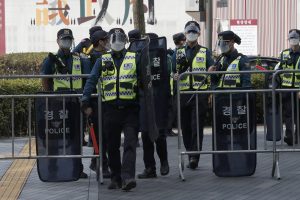Around 300 police buses were mobilized by the South Korean police to put up a wall on October 3 in central Seoul. More than 11,000 police officers were deployed, and there was minimal public access to Gwanghwamun Square. Subways did not stop at stations near the square, while drivers and pedestrians were stopped and asked for their destinations.
The moves were designed to stop planned anti-government protests in the square amid concern over the spread of COVID-19.
The government move, however, met immediate backlash with some saying that the scene reminded them of South Korea’s past dictatorship. Some online users complained that they felt as if martial law was proclaimed in Seoul.
The world is striving to fight against the ongoing pandemic, and South Korea is no exception. In this regard, the government’s decision to block mass protests makes sense. The public also should refrain from taking part in large protests that can lead to local outbreaks. But critics say that the government failed to demonstrate its commitment to uphold the basic constitutional rights that guarantee the freedom of assembly and demonstration for all South Korean citizens.
The government claimed that its move was aimed at preventing the spread of the virus, but to many it appeared designed more to suppress the growing critical voices against the Moon administration.
On the same day, October 3, not only national resorts but also amusement parks were crowded with people. It was estimated that about 20,000 people gathered at Seoul Grand Park on that day.
There was a news report that about 40,000 people visited the Jeju International Airport on October 3, while Democratic Party leader Lee Nak-yeon visited Bongha Village, hometown for the late President Roh Moo-hyun, on October 1 to pay tribute, a move that also attracted huge crowds, mostly thought to be supporters of the current government.
But the police forces were only at Gwanghwamun Square to “stop people from gathering.”
If the government’s goal was solely to prevent gatherings, its move was even more unjustifiable.
Anti-government protesters learned a lesson from mass protests they held back in August. At that time, they faced public criticism for playing a role in the local outbreak; in fact, many participants turned out to have contracted COVID-19.
Therefore, protestors and organizers came up with the idea that they would conduct a so-called “drive-through” protest on October 3. The idea was that people would drive through Gwanghwamun Square and honk as a protest instead of gathering and chanting in person.
The government, however, even blocked that move. It threatened to cancel the driver’s license of those who participated in a drive-through protest and said protesters would also face fines. To many, that was another hint that the government’s concern might not have been entirely about the possible local outbreak.
In fact, this was not the first time for South Koreans to see tight police control over a protest.
In 2011, for instance, police bus walls were set up at the square, and hundreds of police officials were deployed to the scene to control protesters. Apart from this, there were at least two or three similar measures taken by the previous governments; all aimed to block protesters.
Current President Moon Jae-in, who back then was part of the opposition, repeatedly criticized such moves, calling them “unconstitutional.”
“Democracy in South Korea has been blocked by the government’s anti-constitutional police bus walls,” Moon wrote on Twitter in November 2015.
“The president should listen to the people’s cries… instead of blocking the people. In addition, those who are responsible for violent and suppressive crackdown should be punished thorough investigation,” he lamented at that time.
Yet now that he is in power, Moon appears to be more sympathetic to such crackdowns. Anti-government protesters are reportedly planning to hold a rally on a public holiday on October 9, and the government has vowed again to block it.































